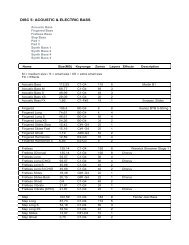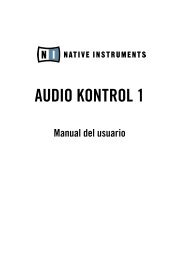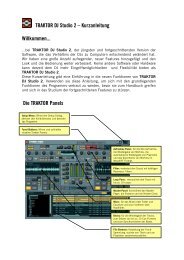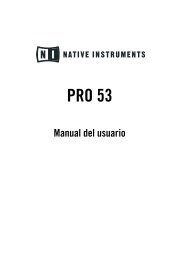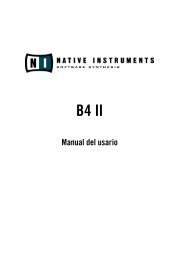KORE SOUNDPACK – North India English - Native Instruments
KORE SOUNDPACK – North India English - Native Instruments
KORE SOUNDPACK – North India English - Native Instruments
Create successful ePaper yourself
Turn your PDF publications into a flip-book with our unique Google optimized e-Paper software.
5.3.2 The Sitar<br />
The sitar is a plucked instrument (a type of lute) and is considered as the main melody<br />
instrument of <strong>North</strong> <strong>India</strong>. It is the rich sound of this instrument many people in the western<br />
world associate with <strong>India</strong>n music, since it was introduced to the Western world in late<br />
60s rock music by people like George Harrison and Ravi Shankar.<br />
The sitar is a complex instrument, both in terms of playing but also from the way it is<br />
constructed. In the main sitar <strong>KORE</strong> SOUND “Authentic Sitar” we have tried to capture<br />
the fascinating resonating qualities of this instrument as well as to come up with a simple<br />
yet powerful way of performing authentic sounding performances with a 61 MIDI note<br />
keyboard.<br />
The sitar usually has 19 metal strings, which are subdivided into these three categories:<br />
►<br />
►<br />
►<br />
the main melody string (plus one auxiliary main melody string) - on this string the<br />
various melody tones and bends are produced.<br />
five “accompaniment” strings - these strings are tuned to the tonic and fifth and are<br />
accompanying the melody.<br />
eleven resonance strings - these strings are located under the other seven strings and<br />
are tuned to a specific scale. The resonance strings are excited by the playing of the<br />
other seven strings.<br />
The following is important about the sitar and its playing:<br />
►<br />
►<br />
►<br />
due to the construction of the frets, bends on the melody strings can easily be performed.<br />
This kind of ornament is very common and important in <strong>India</strong>n music.<br />
accompanying the melody by frequently striking the accompanying strings <strong>–</strong> especially<br />
in the slow introductions <strong>–</strong> is a characteristic trade of sitar playing.<br />
due to the nature of the instrument and the modal principles of <strong>India</strong>n music, the<br />
sitar is best played in a modal context (see below) and not in a chromatic fashion.<br />
NORTH INDIA <strong>–</strong> 16





